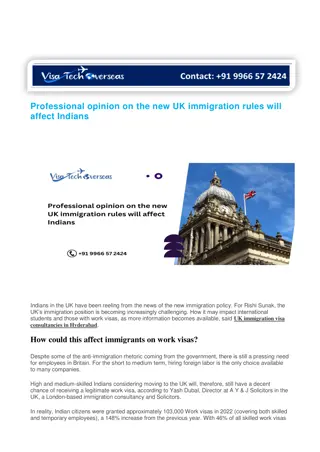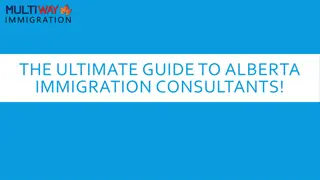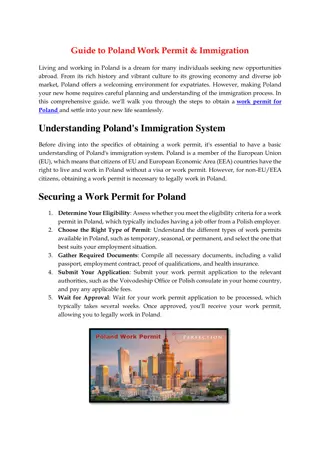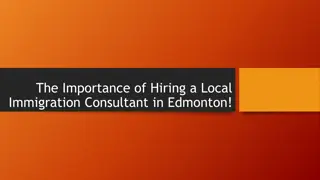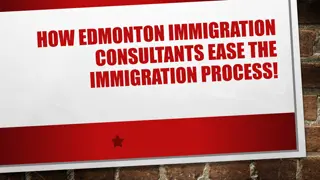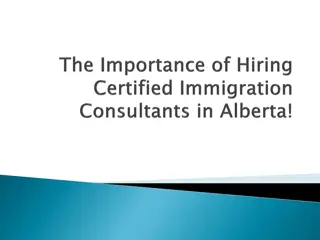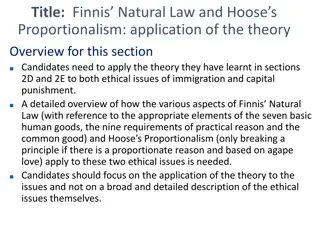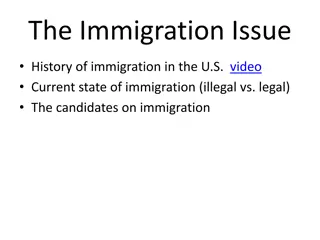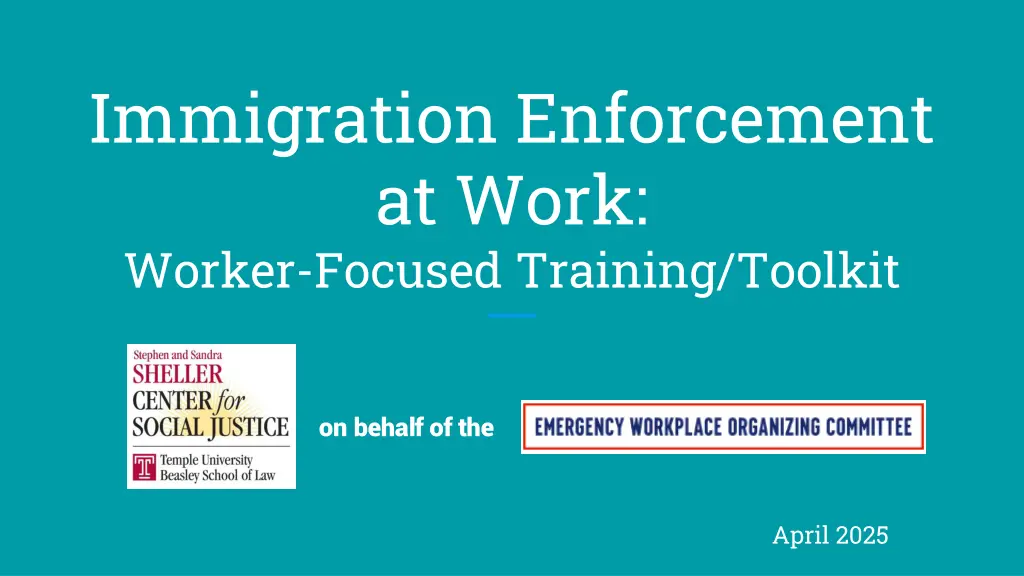
Worker-Focused Immigration Enforcement Training
"Gain insights into immigration enforcement at work with a worker-focused training toolkit for April 2025. Learn how to handle ICE encounters, demand employer policies, and understand I-9 audits and workplace raids."
Download Presentation

Please find below an Image/Link to download the presentation.
The content on the website is provided AS IS for your information and personal use only. It may not be sold, licensed, or shared on other websites without obtaining consent from the author. If you encounter any issues during the download, it is possible that the publisher has removed the file from their server.
You are allowed to download the files provided on this website for personal or commercial use, subject to the condition that they are used lawfully. All files are the property of their respective owners.
The content on the website is provided AS IS for your information and personal use only. It may not be sold, licensed, or shared on other websites without obtaining consent from the author.
E N D
Presentation Transcript
Immigration Enforcement at Work: Worker-Focused Training/Toolkit on behalf of the April 2025
Intro & Goals Intro & Goals Introduction Goals: (1) KYR if ICE shows up at work (2) How workers can demand that their employer adopt policies to protect immigrant workers
KYR if ICE Shows Up at Work
Background: ICE Enforcement Background: ICE Enforcement Who is ICE? Immigration and Customs Enforcement (ICE) is a federal agency that enforces federal immigration laws How does ICE enforce federal immigration law at work? - I-9 audits - Workplace raids
Background: I Background: I- -9 Audits 9 Audits 1. Notice of inspection ICE shows up or sends a notice requiring production of employer I-9 forms. By law employer have 3 business days to respond. Employers do not have to keep copies of a worker s ID or work authorization, or provide more info than is requested 2. Inspection of forms ICE inspects the forms for technical or substantive violations 3. Violations When violations are found, an employer is given 10 business days to make corrections. Employers will be required to stop the unlawful activity of employing, may be fined, and in rare situations may be criminally prosecuted.
Background: Workplace Raids Background: Workplace Raids What are workplace raids? - Unannounced and surprise worksite visit - Agents may seek a specific employee - Agents may more generally seek to identify employees without lawful status How do ICE agents operate? - May be wearing uniforms or in plain clothes - May carry weapons - May try to talk to employees and employer Serge Averbukh Two ways for ICE to enter your workplace: (1) A valid judicial warrant (2) Permission from your employer IMPORTANT: All agents must carry an identification badge
Basic Constitutional Rights: Workplace Raids Basic Constitutional Rights: Workplace Raids Constitutional rights apply regardless of immigration status Right to remain silent - Everyone retains the right to remain silent by refusing to speak to ICE agents during a workplace raids Right to refuse entry into private areas - ICE agents may only enter private areas with consent or with a valid judicial warrant
Basic Constitutional Rights: Basic Constitutional Rights: Public Areas vs. Private Areas Public Areas vs. Private Areas Private Areas Where only staff is permitted. Physically separated from areas open to the general public. Public Areas Where members of the public, such as customers, are permitted Examples: - - Examples: - - Kitchen in restaurant Supply room in retail store Dining room in restaurant Shopping aisles in retail store ICE needs judicial warrant or permission for private areas
Basic Constitutional Rights: Basic Constitutional Rights: Judicial vs. ICE Warrant Judicial vs. ICE Warrant Judicial warrants may authorize more extensive and invasive ICE action. - Issued by U.S. court - Signed by federal judge - States who/what ICE is searching for - States where agents can search ICE administrative warrants do not authorize agents to enter private areas. Administrative warrants ONLYauthorize ICE to detain a specific person.
Basic Constitutional Rights: Judicial vs. ICE Warrant
What can you or your boss do about an ICE raid?
Before Raid: Workers Before Raid: Workers Understand your workplace policies if you have any about ICE encounters Organize your workplace so that you and your coworkers are working together Establish a point person to interact with ICE agents Identify local immigration attorneys & immigrant rights organizations able to provide help in the event of a raid Compile information into a written response plan Post a written response plan in areas where workers are allowed to post other personal information
Before Raid: Employers Before Raid: Employers Clearly mark private areas with visible signs and do not allow the public to enter those areas without permission. Commit to requiring a judicial warrant for ICE to access private area. Establish emergency protocols. Train workers on how to handle ICE and about emergency protocols. Compile information into written response plan in areas accessible to employees and practice with employees.
During Raid: Workers During Raid: Workers Stay calm and stay silent Remind each other that you do not have to talk to ICE agents Wait in private areas No one should run away as it gives ICE agents the justification to detain, arrest, and enter private areas Assign a point person to speak with ICE agents Ask agent for identification Record encounter (if safe) Video recording or taking notes about the conduct of ICE agents can later serve as evidence
During Raid: Employers During Raid: Employers Require a judicial warrant Examine the warrant to see whether it is judicial or administrative Observe whether ICE is complying with what s written in the warrant (e.g., the person, documents, or address listed) If ICE is searching something else, object to those searches Do not talk to or help ICE when you don t have to With an administrative warrant for a specific person, you do not have to say if an employee is working on that day or take them to that employee Do not help ICE by providing information about your employees, such as name, immigration status, country of origin, or home address Record encounter (if safe) Video recording or taking notes about the conduct of ICE agents may later serve as evidence.
Post Raid: Employer Post Raid: Employer Record all facts about raid immediately after (including saving copies of security footage of raid) Notify family members about any detained employee Help secure legal assistance for employees Contact immigration attorney or immigrant rights organization for help post raid Offer leave to affected employees Grant workers leave to get their affairs in order Pay owed & separation wages
Worker Organizing: Get Your Employer to Agree to Best Practices
Worker Organizing: Worker Organizing: Demand Best Practices Demand Best Practices Workers can organize and demand that the bosses commit to key actions that protect immigrant workers Workers collectively are powerful Individual workers too may have leverage that can create pressure on bosses to ensure best practices Even if you do not succeed, workers can still organize among themselves to engage in best practices
Worker Organizing: What Are Some of the Asks? Does your workplace have private areas? If no organize to have your boss create and label private areas Does your workplace have a policy about ICE warrants? If no organize to demand that your boss commit to a policy that only allows ICE access to private areas with a signed judicial warrant Does your workplace have an emergency plan? If no organize to have clear emergency plans in place for all types of potential emergencies Do your employer, manager, and coworkers know about these rights? If no organize to demand that your boss get everyone trained
Worker Organizing: How to Do It? 1) Talk to your coworkers. 1:1 conversations are the best way to build up collective support. Attend an organizing training with EWOC or Labor Notes for free support in building organizing skills or look at their online resources. 1) Identify collectively what you as workers want to see at your workplace for an ICE raids plan. 2) Come up together with how you will make your demands (e.g., oral request, petition) and whether you are willing to escalate to others kind of pressure if the employer does not agree. Ensure that your are engaging in protected concerted activity with coworkers.
Worker Organizing: You Have Rights as Employees Section 7 rights of the National Labor Relations Act (NLRA)* Protects employees who engage in concerted activity at work for the purpose of mutual aid or protection Protects employees from retaliation *NLRA has some exemptions for independent contractors, farm workers, domestic workers, and undocumented workers* U.S. citizens (and other workers with lawful work authorization) may be better able to wield their privilege to make collective demands
Worker Organizing: Model Employer Plan/Policy See Sample Model Policy Handout! Demand that your employer agree to certain policies. For example: ICE is not allowed into private areas without a judicial warrant No information about any employees, such as their name, immigration status, or address, will be shared with ICE without a judicial warrant or subpoena or unless it is part of an I-9 audit Non-retaliation leave and separation and pay policies for workers impacted by ICE raids Demand that your employer come up with an ICE raids plan. For example: Create and label private areas Have a protocol in place, including designated people that will handle any ICE interactions at the workplace Train all workers and supervisors about the plan Put the plan in writing and translate into other languages
Worker Organizing: Sample Petition to Employer Highlights reference to key legal language that action is taken for the mutual aid and protection of workers and is activity that is protected by the NLRA.
Resources: KYR Wallet Cards Available in multiple languages!
Resources: immigration organizations Resources: immigration organizations For general information on your rights during an ICE raid, please visit: For immigration organizations that provide direct representation to immigrants, please visit: National Immigration Law Center https://www.nilc.org/issues/immigration- enforcement/ HIAS Pennsylvania https://hiaspa.org/ Esperanza Immigration Legal Services http://www.esperanza.us/eils/ American Civil Liberties Union https://www.aclu.org/know-your-rights/i mmigrants-rights Nationalities Service Center https://nscphila.org/
Resources: worker organizing Resources: worker organizing For general information and support on how to organize at work, please visit: Emergency Worker Organizing Committee (EWOC) Organizing resources: https://workerorganizing.org/resources/training/ Organizing Trainings: https://workerorganizing.org/training/ Labor Notes Organizing resources (english and spanish) : https://labornotes.org/secrets/handouts Organizing trainings: https://labornotes.org/events




